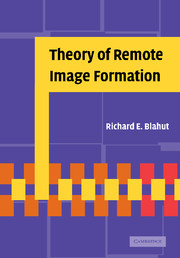Book contents
- Frontmatter
- Contents
- Preface
- Acknowledgements
- 1 Introduction
- 2 Signals in one dimension
- 3 Signals in two dimensions
- 4 Optical imaging systems
- 5 Antenna systems
- 6 The ambiguity function
- 7 Radar imaging systems
- 8 Diffraction imaging systems
- 9 Construction and reconstruction of images
- 10 Tomography
- 11 Likelihood and information methods
- 12 Radar search systems
- 13 Passive and baseband surveillance systems
- 14 Data combination and tracking
- 15 Phase noise and phase distortion
- References
- Index
7 - Radar imaging systems
Published online by Cambridge University Press: 19 August 2009
- Frontmatter
- Contents
- Preface
- Acknowledgements
- 1 Introduction
- 2 Signals in one dimension
- 3 Signals in two dimensions
- 4 Optical imaging systems
- 5 Antenna systems
- 6 The ambiguity function
- 7 Radar imaging systems
- 8 Diffraction imaging systems
- 9 Construction and reconstruction of images
- 10 Tomography
- 11 Likelihood and information methods
- 12 Radar search systems
- 13 Passive and baseband surveillance systems
- 14 Data combination and tracking
- 15 Phase noise and phase distortion
- References
- Index
Summary
A conventional radar consists of a transmitter that illuminates a region of interest, a receiver that collects the signal reflected by objects in that region, and a processor that extracts information of interest from the received signal. A radar processor consists of a preprocessor, a detection and estimation function, and a postprocessor. In the preprocessor, the signal is extracted from the noise, and the entire signal reflected from the same resolution cell is integrated into a single statistic. An imaging radar uses the output of the preprocessor to form an image of the observed scene for display. A detection radar makes further inferences about the objects in the scene. The detection and estimation function is where individual target elements are recognized, and parameters associated with these target elements are estimated. The postprocessor refines postdetection data by establishing track histories on detected targets.
This chapter is concerned with the preprocessor, which is an essentially linear stage of processing at the front end of the processing chain. The radar preprocessor usually consists of the computation of a sample cross-ambiguity function in some form. Sometimes the computation is in such a highly approximated form that it will not be thought of as the computation of a cross-ambiguity function. The output of the preprocessor can be described in a very compact way, provided that several easily satisfied approximations hold. The output is the two-dimensional convolution of the reflectivity density of the radar scene and the ambiguity function of the transmitted waveform.
- Type
- Chapter
- Information
- Theory of Remote Image Formation , pp. 221 - 253Publisher: Cambridge University PressPrint publication year: 2004



